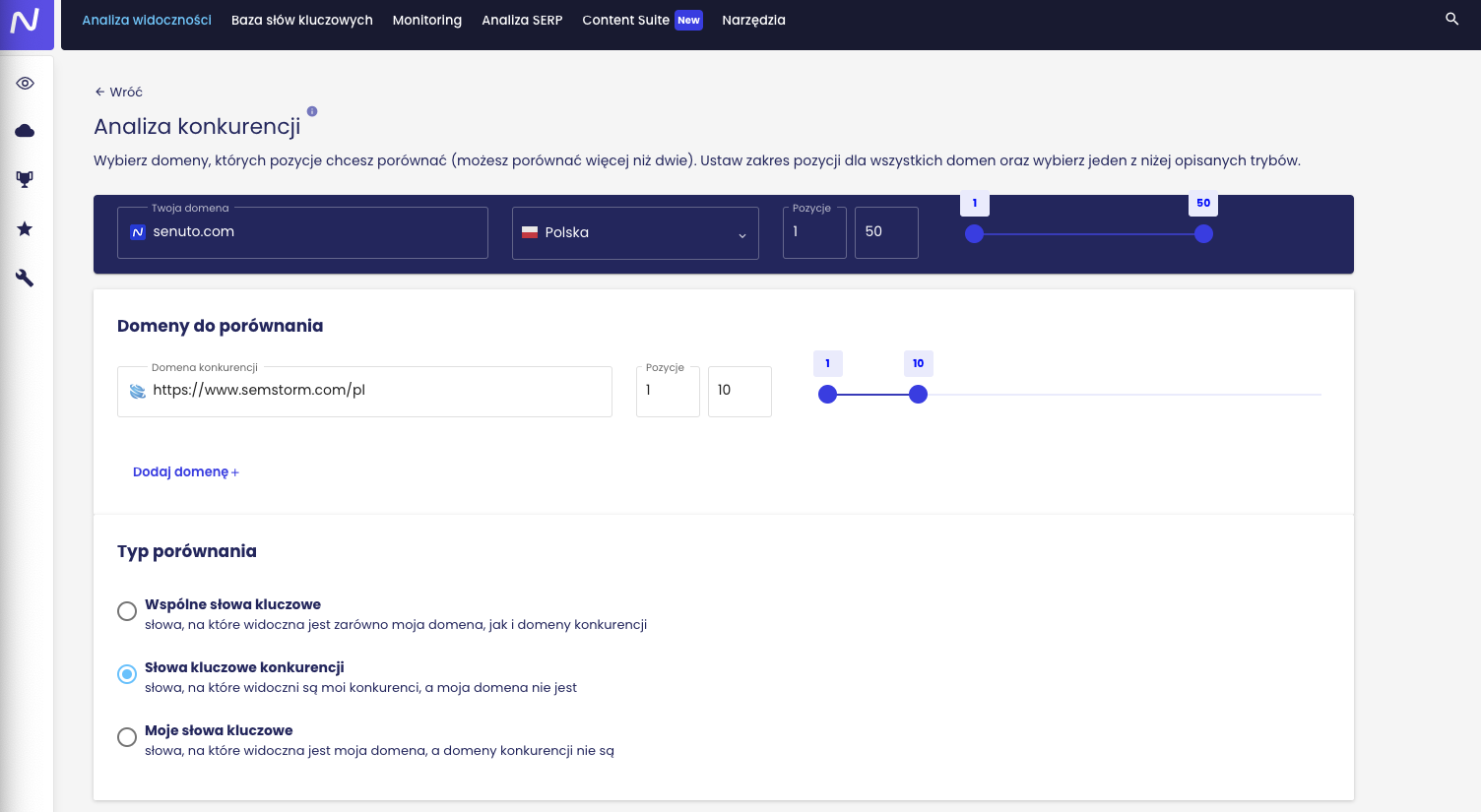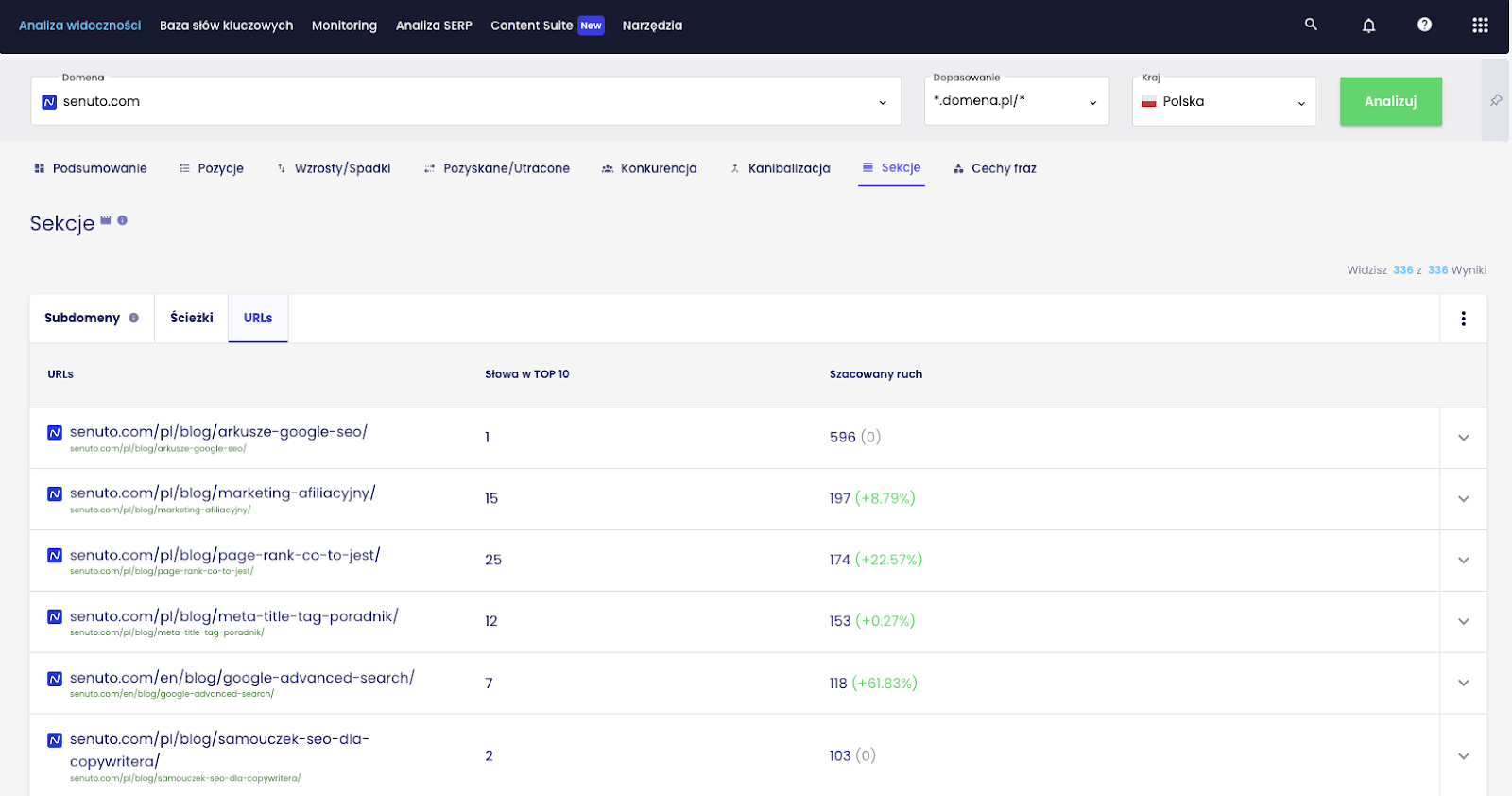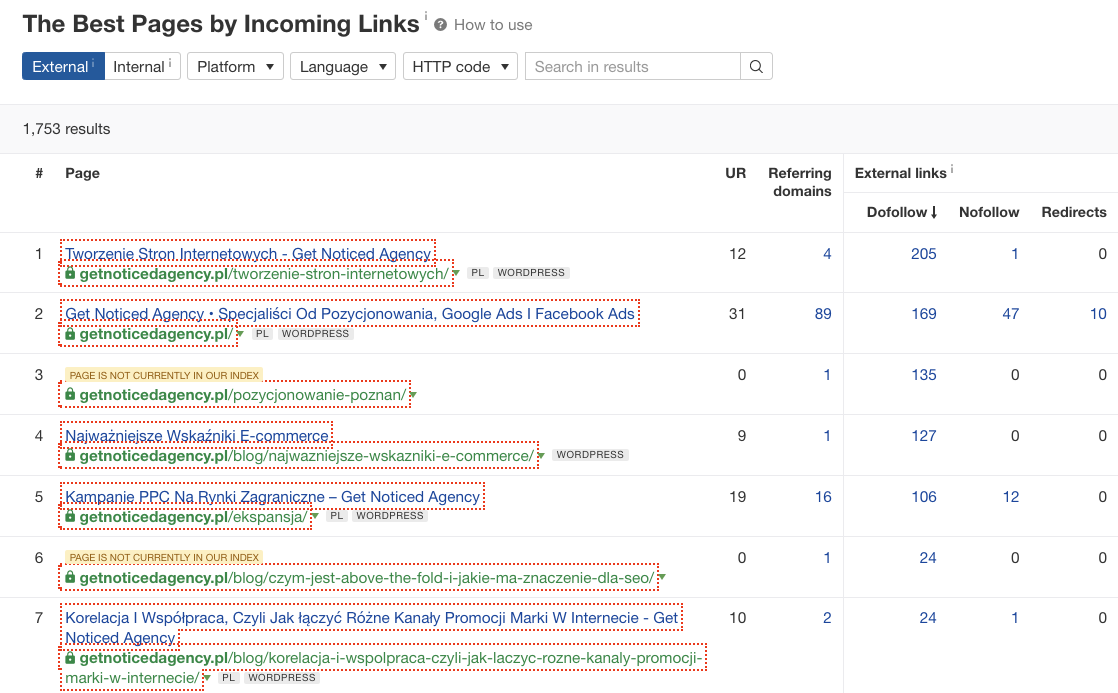What is SEO strategy?
.
An SEO strategy is a set of actions to drive a website to the highest possible page rank. Included in SEO are three areas that need to be managed in order to improve or maintain your performance in organic search results. These consist of:
- technical optimization of the website,
- content activities,
- link building,
.
.
.
The optimal SEO strategy, however, depends on the type of site, the business and the activities of the competition. .
In this post, I would like to focus on how to be inspired by your competitors in determining your individual SEO strategy. Often, such an analysis allows you to assess what issues to pay attention to first, and whether the budget allocated for SEO is adequate, but whether it should be increased.
Content strategy
.
Start with content, which customers often find easy to make up in their opinion. .
But is it right?.
Well, not necessarily..
A big difference in blog content or a lack of descriptions for all categories of an online store can prove to be a problem. Especially when SEO is just one component of running a business. Often, the right person needs to be delegated to such activities, who will only deal with content writing. And there may be a dozen or more texts to write. .
Well, but what kind of content is important?.
Blog content is very important in gaining site visibility and building topical authority. When you write content that answers users’ questions, you are able to gain customers at the interest stage of a product or topic. By doing so, you build recognition for your brand. If, on top of that, you skillfully use call to action in your texts, there is a good chance that you will increase conversions when selling the products covered in the post..
Content GAP
.
Determining Content GAP, or the difference in positioned keywords between you and your competitors, is very important. With this analysis, you are able to determine on which phrases your competitors have an advantage over you. A thorough Content GAP analysis will show you, for example, that you should:.
- expand your site with new sections,
- prepare new blog posts,
- create new texts for the blog.
.
.
You can already see how this can be useful. But how to do content gap analysis?.
The easiest solution is to use the Senuto feature available in the Visibility Analysis tools. This tool is called “Competitor Analysis”..
Filling out the report as I did in the screenshot below will allow you to see which keyword phrases your site is not positioning for, but your competitor’s site is..

The keywords obtained in this way help determine the direction of the site. In the case analyzed, it is certainly worth focusing on the blog and the development of topics such as duplicate content, how to add a site to Google, or a post about links considering the phrases to follow and no follow..
How to choose blog topics based on competition?
.
Methods are several:.
- manual verification of a competitor’s blog – for those without technical SEO knowledge,
- technical verification – using a sitemap.xml file or crawler,
- semi-automatic verification – e.g. using Senuto.
.
.
.
On the subject of manual verification, I will not elaborate much. It’s simply a method that involves manually going through a competitor’s blog and writing down the blog topic URLs and meta titles.
Technical verification can be done by scanning the site for blog URLs. As a rule, these usually contain the /blog/ or /article/ part..
From the URLs collected in this way, the title tag or H1 header can be retrieved, which, if well optimized, contain the title of the post. The resulting list can be a ready-made content plan..
To perform semi-automatic verification, you need a tool such as Senuto..
All you need to do is enter your competitor’s domain in Visibility Analysis, go to the Sections report, and then the URLs tab. This will give you a list of all your competitors’ URLs that are generating traffic.
Of course, not all URLs will be blog posts, so you’ll have to review them manually. However, this can be faster than manual review, as you have a ready-made list of URLs that, if well optimized, include the title of the entry. An example of this is the report for senuto.com..

Publishing frequency of blog posts
.
Frequency of blog post publication is an important factor when planning a content strategy. The golden advice in this case is to maintain regularity of publication. .
This is an example..
You have time to write a dozen or more blog articles and you know that you will not sit down to write for the next six months. What to do in such a situation?”.
The best thing to do is to spread out your article publications over several months. Google values regularity, so publish texts at consistent intervals, such as once a week. .
But how to check what regularity your competitors maintain? .
Here again, we can approach the topic automatically or manually..
To do a manual check, you need to go through each blog post and check the publication date. Just remember that this will consume a ton of your time.
Automatic checking can be done using custom extraction from the Screaming Frog tool. This is a more complicated method that requires knowledge of xPath, but it will take a few minutes to retrieve a list of content publication dates.
Let’s say you already have your article publication dates downloaded and you see that your competitors are publishing 3 to 5 blog articles per month. Now it’s time to get your traffic..
When you’re working on a content strategy, you need to know that you can’t publish at a lower frequency than your competitors, because your competitors will increase their visibility all the time. So despite the fact that you will be running in one direction, the difference in your visibility will constantly increase..
The frequency of content publication also depends on the target audience of your site. If you have a news site, then publications must be frequent. However, if it is a corporate blog, go ahead and publish a few posts per month..
Number of published content
.
Number matters, but so does quality. It’s worth keeping this in mind when planning content activities for your site..
When analyzing a competitor’s blog, check how much of the content has SEO value. A blog is also used to describe company news. This content is irrelevant when building organic visibility. So pay attention only to traffic-generating posts, i.e. primarily tutorials..
To check the number of published content, you can review the site manually or use any crawler (a solution for the more advanced). However, you can only analyze the content for relevance during site SEO in most cases manually. You simply have to read and evaluate everything..
How to plan a content strategy based on this data?
.
At the very beginning, in the Content GAP analysis, you checked what phrases your competitors are positioning for and your site is not. Therefore, you can assign the phrases in the list to the type of page (store category page, offer page, blog post page). .
In the next step, you have obtained a list of competitors’ blog topics. Based on this, review the blog topics that match your business and highlight the ones you want future coverage of. After analyzing the number of published content, you will know how long you have to catch up with your competitors in the number of blog posts. This is important because accurately describing each blog category works positively on topical authority. .
At the very end, put this together with your publication frequency data and you have a ready-made content publication plan. Publication frequency will allow you to determine how much text you should publish on your blog per month. Importantly, if your offer pages or store categories are missing descriptions, then fill them in as soon as possible. Make it a priority..
Remember to prepare additional keyword research for each text, which will include:.
- length of text,
- number of headings,
- content of headings,
- list of key phrases you will use to write content.
.
.
.
This is essential to increase the potential of your texts and build greater online visibility. .
Link building
.
Link building in SEO plays a very important role. Therefore, we should not overlook it in analyzing the competition and determining SEO strategies based on the competition..
Acquiring quality links has a positive effect on increasing the Domain Rating of a domain. High DR plays a very important role in SEO. Suffice it to mention that Google’s first algorithm (PageRank) which evaluated sites for SEO suitability worked by assessing a site’s PageRank. Now, of course, there are more of these factors (e.g., adapting the site to mobile devices), but making sure the site’s DR is high is one of the responsibilities when positioning the site..
Read also: How to do external linking, or link building?.
How many links are your competitors acquiring?
.
This is a very good question to ask at the beginning of a competitive link profile analysis..
To check this, you need (for the moment) to use tools like Ahrefs or Semrush. It is from them that you will find out how many links and how many domains are pointing to your competitor’s site.
You absolutely must compare your competitors’ data with your own. During such analysis, you may find that you have significantly more or less links than your competitors..
What sites are your competitors getting links from?
.
Checking which sites your competitors are getting links from is important, as this allows us to make up for the link gap. This is a method used in SEO. It works on a similar principle to the content gap, however, it includes not texts but links..
If you want to know this, you need to download the link sheets of the domains linking to your site and your competitors’ sites, and then, for example, using the vertical search function, find the domains that link to your sites. In this way, we exclude common links. The links that remain are the ones you can try to acquire..
How to do it? The best way is to use platforms such as Whitepress and see if they offer to buy links just from those domains..
What sites are your competitors linking to most often?
.
To check this, we need to use external tools, usually paid ones. Determining what pages your competitors are linking to most often will help determine what your competitors’ SEO priority is. If the site has a lot of quality links to a particular category page, it can assume that they care a lot about the positioning of this address..
Remember, the number of links from sites with a high Domain Rating to a category page positively affects the positions of the phrases for which the site is positioned..

What anchors are your competitors getting links from?
.
Anchor is a sub-linked text, which is a link. Most often it is highlighted in some way such as bold, underline or other color. Therefore, it is easy to find it in the text. As for anchors, we have several types of them. The most common are:.
- URL – the URL itself,
- exact match – the link is placed on the positioned keyword,
- brand – link placed on brand name,
- generic – link is placed on text like: read more, here, etc.
.
.
.
.
Proportional distribution of anchors is very important. The exact match anchor types alone should not be used (although they do tell you what the page you are going to go to is about). Therefore, make sure your link profile is as diversified as possible..
How, then, to take advantage of this during competitive analysis?.
Mimicking the actions of your competitors, you can try to map their link diversification. If there are 40% exact match anchors, 30% URL anchors and 30% other anchors leading to a category page, you can try to map this during your link building efforts.
On the other hand, if you notice that your competitors are mainly acquiring links to your pages in the form of generic links, then you can plan to acquire exact match links and from URLs..
What to do with your competitors’ link profile data?
.
Simply put, plan your link building strategy..
When you take the first step, you will find out what the overall link situation of your competitors is and how much difference separates you. .
After doing a link gap analysis, you will plan from which domains you need to acquire links to try to chase your competitors..
By determining the most frequently linked sites, you will see if your SEO priorities coincide with yours. Use this data to plan which pages on your site you should link to as often as possible..
Add an anchor strategy (last point) and a basic link building strategy based on competition is ready..
Remember also that you can use link acquisition as part of your company’s advertising campaign – for this purpose, publish advertising content on popular sites..
Menu
.
A well-designed menu is the foundation of SEO. It’s where links to the most important sections of the site should be located. That’s why it’s a good idea to compare the menu on your site, with the menu on your competitor’s site. During the analysis, you may find that your competitor links to other pages that are also very important on your site, or better replicates the site’s hierarchy, e.g. has greater nesting..
When analyzing menus, however, it’s a good idea to check the overall visibility of sub-pages on the site. Not every action of a competitor may be a good one. If a menu-linked page doesn’t generate visibility (and you’ve checked this with Senuto), it may not be worth putting the same category on your site. Then still make sure that there are inbound links to the page and that the page has completed content..
The same applies to your site. Just putting a new sub-page on the menu, if it does not have completed text, will not guarantee SEO success..
Missing categories
.
For online stores, category pages are responsible for sales. They are the ones that get traffic and from them potential customers get to product pages – from which they are just a few clicks away from making a purchase.
This is why it makes sense to go through your competitor’s category pages. It’s possible that your competitor has well-described category pages that your site doesn’t have, or offers access through filters (which may exclude them from indexing).
Of course, before deciding to include a missing category, you should check the potential of that category. The best way to do this is by using the Senuto Keyword Database. Simply enter the category name there. If the potential of one category is 10 searches per month, it is unlikely to be worth taking action on it. However, look at the effect of scale and see what the search volumes look like for several or a dozen such categories. It is also a good idea to verify whether the products sold in the category are high-margin. If the answer is yes, then action should be within your circle of interest..
You may also find that your competitors have more categories, as your stores differ in assortment. In that case, analyze the missing products as well..
Missing products
.
Analyzing missing products is more engaging because it requires a broader approach to marketing..
If you don’t have the products in question, you first need to source them, place them in the store, and then position them.
However, it is worthwhile to analyze the products that your competitors offer, as this could be an opportunity for additional income in your business. With new products you are able to create new categories with high market and SEO potential..
Summary
.
Good SEO competitor analysis gives your site a better chance to be competitive. When running a small business, you can model yourself after larger players or your closest competitors. The steps I’ve described are not the only steps to take when determining an SEO strategy for a website. It is one component of the total actions that can be taken during SEO..
 Jakub Trybuła
Jakub Trybuła